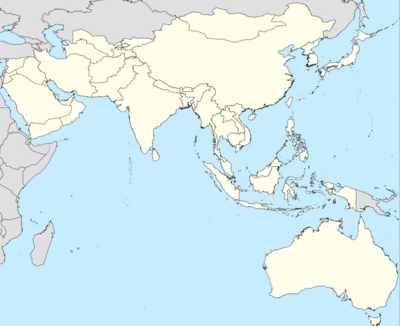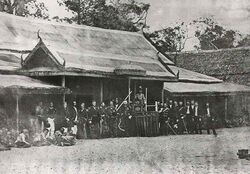Astronomy:Solar eclipse of August 18, 1868
Script error: No such module "Solar eclipse". A total solar eclipse occurred on August 18, 1868, also known as "The King of Siam's eclipse". A solar eclipse occurs when the Moon passes between Earth and the Sun, thereby totally or partly obscuring the image of the Sun for a viewer on Earth. A total solar eclipse occurs when the Moon's apparent diameter is larger than the Sun's, blocking all direct sunlight, turning day into darkness. Totality occurs in a narrow path across Earth's surface, with the partial solar eclipse visible over a surrounding region thousands of kilometres wide.
The eclipse was predicted more precisely by King Mongkut of Thailand than it was by French astronomers. The eclipse allowed for the discovery of helium by both Pierre Janssen and Norman Lockyer, who observed Solar prominences with spectroscopes.
Observations
Several expeditions were sent to observe the eclipse.
- One of two expeditions from Germany was sent to Aden. The expedition was led by Gustav Spörer.[1]
- The second expedition was sent to the west coast of India. The expedition was led by Friedrich Tietjen.[2]
- Captain Bullock observed from the Celebes sea, sketching the appearance of the corona,[3] while Gustav Fritsch accompanied an expedition to Aden.[4]
Discovery of helium
French astronomer Pierre Janssen observed the eclipse from Guntur in Madras State, British India. It was the first total eclipse since Gustav Kirchhoff's 1859 theory that the Fraunhofer lines in the solar spectrum correspond to the emission line of the different chemical elements present in the Sun. Correspondingly, Janssen observed the eclipse with the aid of a spectroscope. He noticed a bright yellow line (λ = 587.49 nm) in the spectra of the solar prominences that could not be due to sodium as had previously been assumed, and was subsequently able to observe the same line even without the need for an eclipse. The same result was found independently by British astronomer Norman Lockyer, and both Janssen's and Lockyer's communications were presented to the French Academy of Sciences on October 26, 1868.[5][6]
King Mongkut's calculation
King Mongkut, also known as Rama IV of Siam, was able to calculate and predict the solar eclipse two years earlier.[7] The calculations were correct as to the place, the time and the type of the solar eclipse that would happen. The eclipse took place precisely as the king had predicted, the total phase lasting six minutes and 46 seconds. In fact, his calculations were better — by about two seconds — than those of the French astronomers, who acknowledged his accuracy. Mongkut was exposed to malaria, then developed chills and fever. He died on October 1, 1868.[8] According to the Thai Astronomical Society and NASA, this eclipse is known as "The King of Siam's eclipse".[7][9]
Related eclipses
It is a part of solar Saros 133.
Inex series
Solar Inex series 2013 May 10
- Saros 131: Annular Solar Eclipse of 1810 Sep 28
- Saros 132: Annular Solar Eclipse of 1839 Sep 07
- Saros 133: Total Solar Eclipse of 1868 Aug 18
- Saros 134: Annular Solar Eclipse of 1897 Jul 29
- Saros 135: Annular Solar Eclipse of 1926 Jul 09
- Saros 136: Total Solar Eclipse of 1955 Jun 20
- Saros 137: Annular Solar Eclipse of 1984 May 30
- Saros 138: Annular Solar Eclipse of 2013 May 10
- Saros 139: Total Solar Eclipse of 2042 Apr 20
- Saros 140: Annular Solar Eclipse of 2071 Mar 31
- Saros 141: Annular Solar Eclipse of 2100 Mar 10
- Saros 142: Total Solar Eclipse of 2129 Feb 18
- Saros 143: Annular Solar Eclipse of 2158 Jan 30
- Saros 144: Annular Solar Eclipse of 2187 Jan 09
Notes
- ↑ Gustav Spoerer (1869). Die Reise nach Indien zur Beobachtung der totalen Sonnenfinsterniss am 18. August 1868: Vortrag gehalten in der Singakademie zu Berlin am 16. Januar 1869. Engelmann. https://archive.org/details/bub_gb_PkBSAAAAcAAJ.
- ↑ Zeitschrift. D. Reimer. 1870. pp. 608–. https://books.google.com/books?id=BTNCAQAAMAAJ&pg=PA608.
- ↑ Edward Walter Maunder, British Astronomical Association (1899). The Indian Eclipse, 1898: Report of the Expeditions Organized by the British Astronomical Association to Observe the Total Solar Eclipse of 1898 January 22. Hazell, Watson, and Viney. p. 113. https://archive.org/details/indianeclipsere00assogoog.
- ↑ Standard Encyclopaedia of Southern Africa
- ↑ Leggett, Hadley (August 18, 2009), Aug. 18, 1868: Helium Discovered During Total Solar Eclipse, wired.com, https://www.wired.com/thisdayintech/2009/08/dayintech_0818/, retrieved 2010-03-18.
- ↑ "Comptes rendus hebdomadaires des séances de l'Académie des sciences", C. R. Acad. Sci. Paris 67: 836–841, 1868, http://gallica.bnf.fr/ark:/12148/bpt6k3024c.image.r=comptes-rendus+hebdomadaires+Acad%C3%A9mie+des+Sciences.f836.langFR.
- ↑ 7.0 7.1 ๒๐๐ ปี พระบาทสมเด็จพระจอมเกล้าเจ้าอยู่หัว พระบิดาแห่งวิทยาศาสตร์ไทย. (in Thai)
- ↑ Montes-Bradley, Saul M.. "Descendants of Danyell Broadley de West Morton". http://www.bradleyfoundation.org/genealogies/Bingley/tobg88.htm#21153. "King Mongkut's prediction surpassed those of European scientists. "In the 19th century, King Mongkut of Siam (now Thailand), an amateur astronomer, paid the ultimate price for eclipse-chasing: his life."
- ↑ Candey, Robert. M. (28 Sep 2009). "Solar Eclipses of Historical Interest" (in en). NASA. https://eclipse.gsfc.nasa.gov/SEhistory/SEhistory.html#1868.
References
- NASA chart graphics
- www.starwrite.org: Solar Astronomy in 1868
- Observations of the Total Solar Eclipse of August 18, 1868 by Charles G. Perrins
- Drawing of Corona
- Mabel Loomis Todd (1900). Total Eclipses of the Sun. Little, Brown. https://books.google.com/books?id=FI0-AAAAYAAJ.






